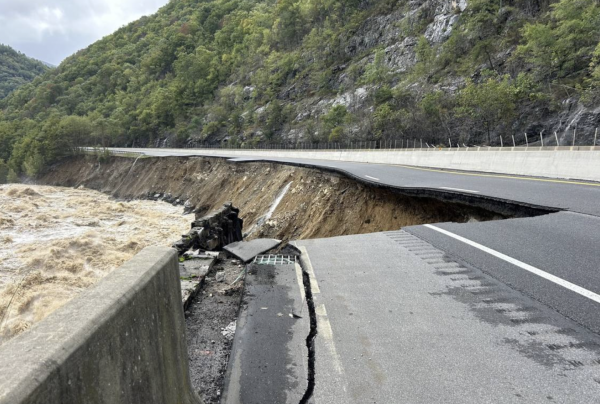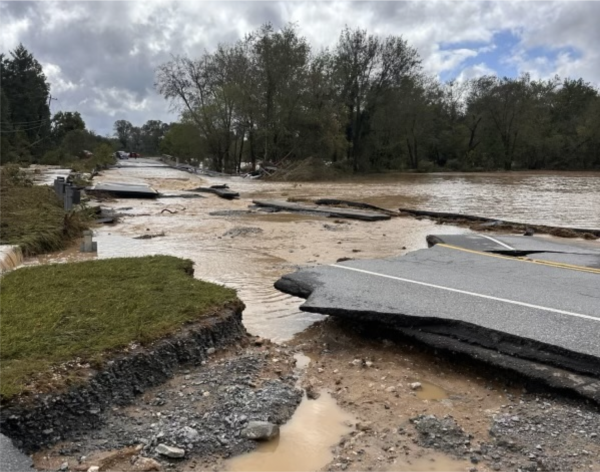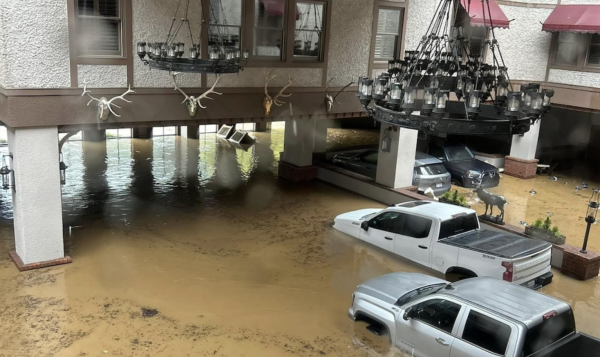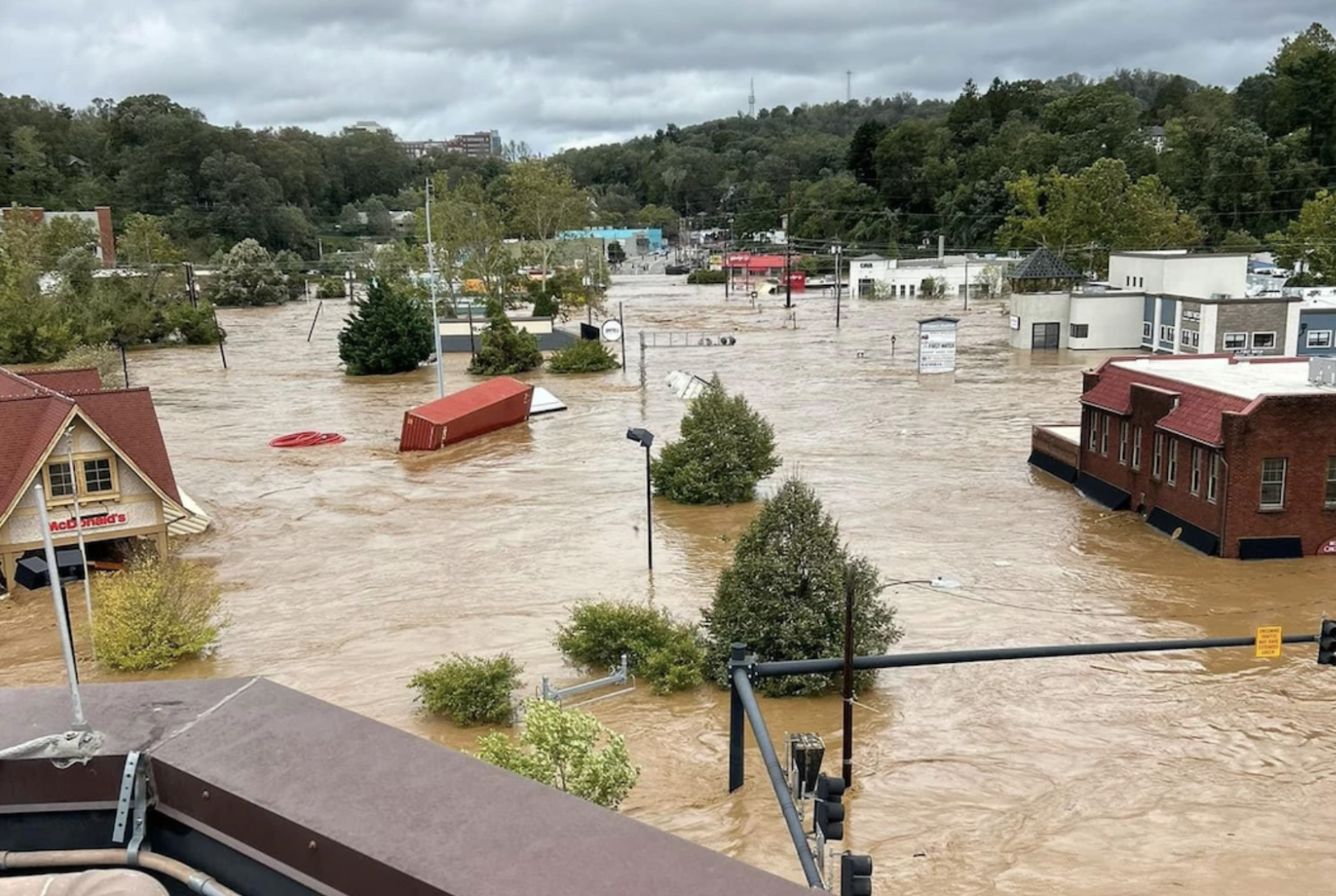Josh Queen wasn’t prepared for a hurricane that was never supposed to come.
Although there were warnings issued, these alerts hardly differed from similar storms in Asheville’s past. While residing in an area of the state where hurricanes are rare occurrences, Queen was informed Thursday morning that Hurricane Helene would bring heavy rain and flooding. Schools were scheduled to close. The area prepared for a day filled with rain and storms, but the devastation that came next was unparalleled.
Schools and hospitals temporarily lost power; however, the thought that the road closures, power outages and the number of casualties which would ensue was unfathomable to many locals.
The next day, the storm hit.

Queen woke up on Friday morning to what sounded like “freight train after freight train barreling past our house.” Trees started collapsing and houses began to tear apart.
“We knew it was coming and was warned that it had the potential to cause the worst flooding our area had seen since the flood of 1916, but we had no idea,” said Queen – and he’s right. Asheville is a city tucked into the Blue Ridge Mountains and has a population of less than 100,000 people. It is known for a vibrant artistic and cultural atmosphere, but not its vulnerability to storms.
The Category 4 hurricane stormed the state Sept. 27, driving its way through western North Carolina. Wind gusts reached up to 60 mph and a peak rainfall of 4.26 inches destroyed entire towns.
Over the next several days, 418 roads closed and nearly one million residents lost power. The French Broad River that crosses Tennessee and North Carolina flooded 24.67 feet, surpassing its previous record of 23.1. Rescue efforts continued as federal and state-level emergency responders were dispatched to the region.
At the time of publication, the North Carolina Chief Medical Examiner declared 42 casualties from the storm. The number is expected to rise.
Queen described the scene in Asheville as grim. Many still wait to evacuate via helicopter, as food and water supplies from FEMA are dispatched.
“It took about [two] and a half days for resources to start coming in to the area to help those in need. Roads are destroyed, bridges are simply washed away and normal is something that we won’t know for a long time,” he said.
“We were so fortunate but to see the absolute destruction of the place we call home breaks our hearts.”
Prior to Helene, the thought of damage on this scale was improbable for residents of a mountainside location. The hardest hit region of the hurricane – western North Carolina – included other cities in the mountains. As rescue continues, the damage from Helene’s storms are expected to have far-reaching implications for its victims.
Miscommunication plagues evacuation efforts
Some mountainside residents initially intended to brave the storm. Once it became apparent that evacuation was the safest course of action, many had already lost power, making communication difficult.
Former Green Hope student and current University of North Carolina, Asheville environmental science major Nora McDunn was one such resident. She was notified that her classes would be canceled Thursday and Friday. As she went to bed Thursday evening, she expected rain and power outages throughout the weekend.
The rest was a blur: Friday, students were told to stay in their residence halls – porta potties were delivered as toilets stopped working. Saturday morning, fallen trees littered the streets and evacuation orders were issued. McDunn wouldn’t resume school until Oct. 28 – a month after the hurricane hit.
Few expected the storm to be as dangerous as it was. At first, McDunn chose to wait out the hurricane. She suspected that the school started encouraging students to leave once supplies dwindled, which was later verified by an alert on her phone: “food and resources were diminishing.”

“I don’t think they have enough resources, Saturday morning when they were telling people to evacuate as soon as they could,” she said.
McDunn’s evacuation mirrored the experience of many. As she and several friends drove out of the city, they saw the damage to its full extent for the first time. McDunn described what she called “apocalyptic” scenes.
“When I was leaving Asheville is when I first saw the extent of everything. We didn’t have service or power, so I got to experience everything for the first time with my own eyes. The campus is up on a hill and I feel extremely privileged to live on campus where we didn’t experience any flooding in our building as far as I know,” she said.
People abandoned cars, properties and valuables to escape. “We saw a car dealership partly underwater, as well as houses and cars. There were abandoned cars everywhere and fallen trees in every yard.”
Announcements were written on paper, because many didn’t have access to backup generators or solar panels. Some were also unable to relay communication to their families. “They couldn’t provide paper maps and it was hard to interpret the verbal directions we were given,” said McDunn.
Cash, rather than credit cards, became the norm. If it wasn’t for $50 in her pocket, McDunn and her friends would not have been able to afford enough gas to drive home.
Federal and state-level aid deployed
Rescue and recovery operations are ongoing for those who didn’t leave. FEMA delivered trailers of food and water on Tuesday, Oct. 1, and promised another of solely water for 34 counties. Distribution areas also included free WiFi. Additionally, 25 shelters opened for victims.
A total of 57 search and rescue teams are scanning the area. An additional 440 were rescued and 4,700 were evacuated. 110 pets were also rescued.
Federal funding from the White House gives survivors access to FEMA’s Individual Assistance. Successful applicants can receive money for emergency services, temporary housing, and property loss. People across the western half of the state and the Eastern Band of Cherokee Indians are eligible.

“The response to this crisis so far has been a massive effort of coordination and logistics,” said Governor Roy Cooper, in a press release. He elaborated on the extent of the storm’s reach, describing it as “unprecedented.” “Hurricane Helene has caused unprecedented devastation across Western North Carolina and we are leading an unprecedented response to surge food, water and needed supplies into these communities.”
As people continue to await evacuation, victims express gratitude from both the western North Carolina community and national efforts to aid survivors.
“This experience has changed me and I do feel like a different person. I went about 36 hours with no power or service and about 24 without running water. Seeing all the people waiting in line for breakfast Saturday morning really hit me in a way to see all these people and we were going through it together,” said McDunn. She hopes that volunteer-based assistance continues to flow into the area.
“I think people should understand that everyone there is a person and the whole country should be working together to provide relief for all the communities affected.”
She also highlights the resilience demonstrated by Asheville residents, despite the calamity that swept the area. “I think it will be a long time and I am so sad for the people who have lost their homes and family members,” McDunn said.
The road to recovery
Others aren’t so sure. Despite collaborative efforts to bring survivors to safety, recovery is expected to be a long and expensive journey.
Shawna McDonald, a current Appalachian State University student, described the difficulties in escaping and remaining informed as power outages wiped out entire counties.
“I felt really disconnected from what was going on on campus. I was worried about my friends, but I just tried not to worry, I hung out with roommates and distracted myself,” she said. “I live on top of the mountain, so I started freaking out. What if we are stuck?”
Although the student is a recent expat from Fayetteville, even her experience with the storms in her hometown hardly measured up to Helene’s impact. “I’m from Fayetteville so we’ve been through hurricanes before, but nothing compared to what is going on right now,” she said.
Coastal cities typically implement both man-made structures – levees, sea walls – and nature-based ones – wetlands – as forms of anti-flood infrastructure. Cities further inland like Asheville, situated near mountains, do not. Without the proper preparation to resist storms like Helene, the damage could impact the economy and community in the long-term.
“The infrastructure is so different. In other places they could’ve fixed it quick, but some places here they can’t even get to. So many roads and towns are just gone,” said McDonald. “It’s going to take years to recover.”
























Mary Phillips • Oct 4, 2024 at 7:18 pm
Thank you for reporting on the recent hurricane and its devastating impact on WNC. Hopefully, this will not only raise awareness of the challenges many small counties are facing but also inspire action. Together, we can help WNC rebuild and recover. #WNCStrong